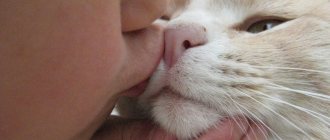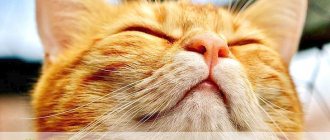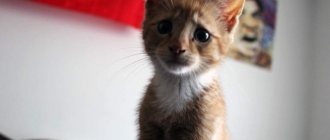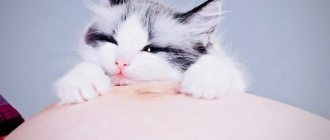The ancient Egyptians were deeply devoted to their cats and worshiped them for two main reasons.
For starters, they helped protect agricultural products from rodents that would feed on different crops, thereby spoiling them. Secondly, people worshiped many cat goddesses as they were said to bring fertility and good fortune to households. The ancient Egyptians respected the many creatures that shared space with them. However, cats in particular held a special place in the homes and hearts of many from this ancient region. Although they worshiped several other creatures, they loved cats the most. The Egyptians loved cats so much that they often put their cats' safety above their own. For example, when there was a fire in the house, the Egyptians would first rescue their cats and then return for other personal belongings. When their pet cat died, the family shaved its eyebrows in mourning and continued mourning until the eyebrows grew back.
Obviously, one could pause and ask why the ancient Egyptians loved their cats so much?
Well, the ancient Egyptians valued their cats for two main reasons: First, because they protected agriculture from being eaten by rodents, and second, because they were deeply rooted in their faith and belief systems.
How cats appeared in Ancient Egypt
Representatives of felines, according to researchers, first lived in the country in a wild state, like other animals. However, the process of their taming and domestication gradually took place. The common breed of cat is usually called the African wild cat or jungle cat.
It is widely known that the country's economy in ancient times was largely based on irrigation agriculture using the floods of the Nile River. Therefore, one of the main food products of the population was bread cakes. Therefore, the country paid great attention to the safety of the collected grain. Mice and other rodents often ate grain stored in houses. Therefore, residents looked for ways to combat them.
And so they noticed that wild cats catch mice and therefore can help solve the problem of rodent control. This observation prompted the Egyptians to deliberately domesticate cats. For example, they deliberately left fish near their houses so that cats would come to their homes and stay there. Gradually, animals became accustomed to living in and around people’s homes.
Also, one of the problems in the country was poisonous snakes that periodically crawled into people’s homes. Cats also successfully caught snakes. As a result, it turned out that these animals brought different benefits to people. They also took part in hunting other animals. Various images of the era of ancient Egypt have been preserved, where cats are drawn together with people, which shows their prevalence and positive attitude towards them.
Sacred cats of Egypt
Egyptian artists did not skimp on depicting the sacred animal in any form on tomb slabs and papyrus. They sculpted them from bronze, gold, stone and wood, made them from clay, and carved them from ivory. Young Egyptian women wore amulets with images of cats, which were called “uchat” and were a symbol of fertility. Young girls passionately prayed to the goddess Bast for the fulfillment of their desire to have as many children as the kittens depicted on their amulet.
And here's some more interesting information about the life of cats in Cairo in the 19th century
The British orientalist Edward Lane was in Egypt in the 30s of the 19th century. He outlined his notes about the life of the Egyptians of that time in the book “Morals and Customs of the Egyptians.” On the pages of this book, he mentioned an interesting phenomenon from the life of the people of Cairo. “And here’s another funny feature from the life of the Egyptian capital: all the stray cats are fed at the expense of the Cairo qadi (chief judge), in other words, they are dependent on him. Every day, in the afternoon, offal is brought to the large courtyard in front of the Mahkama (place of legal proceedings), and the cats are called to a meal. Bash-Katib (the chief scribe of the qadi) told me that Sultan az-Zahir Baybars (a 13th-century Mamluk sultan) in his will denied cats a garden next to his mosque.
The garden is called Gheit al-kutta (Cat Garden). However, the garden was still sold by the executors under the pretext that it was too neglected and its maintenance brought only losses. Then this garden passed from hand to hand for a long time. Now the annual income from it is hekr (land tax) of only fifteen piastres, deducted in favor of stray cats. As a result, the care of the cats fell to the city cadi. On duty, he is the official manager of all funds bequeathed to works of mercy.” Until now, both in Cairo and in Damascus, Istanbul and other Muslim cities you can see many cats.
Goddess with a cat's head
Among the pagan idols in ancient Egypt was Bastet. She was originally depicted with the head of a lioness, that is, a representative of the felines. When wild cats were tamed, she was depicted with the head of a cat. This happened around 2000 BC - the time when cats were supposedly domesticated. Bastet was considered an expression of fertility and home. Also, the ancient Egyptians made a connection between it and the moon.
It is widespread in ancient Egypt, the city of Bubastis was considered the center of Bastet, and a building was built there for its idols. During excavations of this city, mummified burials of these animals were found. The court of Pharaoh Shoshenq was also located here. Images of cats are found on the tombs of pharaohs and other people of that time.
How did ancient Egyptian cats live?
The attitude towards cats was special. Science indicates that the cat was a sacred animal of ancient Egypt. They tried to provide comfortable conditions for them. They were carefully looked after and fed the best food. If they fell ill, their owners went to special pagan priests in the Bastet buildings and gave a certain amount of food. The cats living in these buildings had their own special servants who fed them, played musical instruments and took care of them in other ways.
If cats died, they were given a special funeral. They were mummified, and the coffin was made as expensive as possible using gold, carvings, and precious stones. The family whose pet died observed mourning and ate little in the days immediately after the pet’s death. If someone killed a cat, it was severely punished with a very large fine or even the death penalty. In these cases, much depended on the social and property status of the owner.
LiveInternetLiveInternet
No less interesting is the ancient Russian mythology associated with cats. The Slavs have a legend about an underground cat with fiery ears that guards treasures and scares away wolves. This legend is especially famous among Ural gold miners. And there are so many legends, customs and beliefs that the Russian people have about cats. Some of them are not only known to this day, but also play a big role in the lives of superstitious people who live according to signs. A cat can predict the weather, protect a house from evil spirits, prophesy the arrival of guests, and unmistakably distinguish an evil person from a good one. And in fact, many signs come true. Especially if you believe in them unconditionally.Proverbs and signs:
- A black cat shows its tail from the chimney (smoke) - A white cat climbs into the window (about the dawn sun) - A cat washes itself - to guests or a change in weather. - A cat lies with its belly up - towards warmth, hides its head - towards cold, fluffs its tail - towards a snowstorm. — The cat is plagued by the ninth death (about the vitality of cats) — The tongue is as lascivious as a cat — The cat would have blurted out, but his tongue is short
Cats are known to love affection, home warmth, cleanliness and comfort. At the same time, cats are the most independent and proud animals among those tamed by humans. Cats are people who are secretive, affectionate and deceitful.
If a cat is a pronounced female image, an animal that loves the comfort of home, then a cat is a free, wandering creature, the embodiment of lust and hidden power. The learned cat Bayun (storyteller) is a frequent guest of Slavic fairy tales. His sonorous voice scares away spirits for many miles around.
Cats are attached to the house more than anything, even more than to the owner. There have been cases where a cat remained in an old, cold house when people moved to a new one. In this way, cats resemble brownies, faithful to their corner until its complete destruction.
Black cats were considered assistants to sorcerers and witches, and meeting them was a bad omen. Witches rode around on cats and goats. A hostile spirit can enter a cat’s body to escape persecution or to enter a person’s home. In this form, a witch can ride a horse or even a person to death.
A werecat was also called a cat-cat. A cat, jumping over a dead man, will certainly turn him into a vampire. Whoever kills a cat will incur seven years of troubles and misfortunes.
The eternal confrontation between the cat and the mouse reflects the struggle between two forces - earthly and underground, accumulating and creative, dark and hidden (Veles) and heavenly, furious and renewing thunderstorm power (Perun).
Cat time is winter. Colors – black, white
A cat is a domestic animal, endowed with dual symbolism and various demonic functions in folk beliefs and often paired with a dog.
The cat is assessed ambiguously: both as a clean animal and as an unclean one. They say: “The cat’s fur is dirty, but its snout is clean; The dog’s snout is dirty, but its fur is clean”; “You can kiss a dog on the face, not on the fur; a cat, vice versa.” According to Bulgarian beliefs, the cat rejoices at the death of its owner, and the dog cries; The cat adds to the owner's torment in hell by fanning the flames under his cauldron, and the dog carries water and pours on the fire. Beliefs explain the origin of the Cat both from the devil and from the glove of the Mother of God. In the legend of the Flood, the Cat saves Noah's Ark by plugging its tail into a hole that had been gnawed by a mouse created by the devil. It is forbidden to kill the Cat, otherwise there will be no luck in anything. It is believed that if a person sleeps with a Cat, his mind will become clouded. It is dangerous to carry the Cat with horses, because it makes the horse dry out. Cats are not allowed into the church. Cats and dogs should not be allowed to eat food consecrated in church. However, the Poles sometimes gave them specially blessed bread and butter at Easter. This custom is explained by the popular idea that people have bread thanks to the Cat and the Dog: according to the widespread legend about the ear of bread, because of their disrespectful attitude towards bread, people now use bread, which God left only for the share of Cats and Dogs. It is a bad omen if a Cat (any cat, not just a black one) crosses the road or meets you on the way. For hunters and fisherman, a meeting with the Cat promised failure in fishing. In this regard, they tried not to mention the Cat during the hunt or called it something else (for example, casserole).
In the guise of a black Cat, evil spirits are often represented. At the same time, the Cat is believed to be able to see evil spirits invisible to humans. A devil may appear in the form of a Cat. In cat form they represent the souls of the dead, especially those who atone for their sins after death or did not die a natural death. Death is shown to young children in the form of a Cat. The black Cat was also seen as the embodiment of diseases: cholera and “cow death”. Russians believe that black cats and dogs protect the house from lightning, but they also consider it dangerous to have them in the house during a thunderstorm. This is explained by the belief that during a thunderstorm, God tries to strike the devil with lightning, and the devil hides from God, turning into a cat, dog or other animal. Ukrainians have a well-known story about how a forester, during a thunderstorm, saw a black cat that was not affected by thunder, and shot it with a blessed tin button. After this, St. appeared to him in a dream. George said that he killed Satan, who had been teasing the saint for seven years.
The cat has the characteristics of a domestic patron. Its presence in the house has a beneficial effect on the household and livestock. They believe that a stolen Cat brings happiness to the house. And there are no cats in an unhappy house. When moving to a new house, owners often let the Cat into it first, and only then move in themselves. Entering after her, the owner goes to the corner that the brownie should choose for himself. When a Cat is brought into a new home, it is placed on the stove next to the chimney, i.e. where, according to popular beliefs, the brownie lives. There are often stories about a brownie who turns into a Cat.
The cat is used in folk magic and medicine. They believe, for example, that a black cat has a miraculous bone. If obtained, it can make a person invisible or give him the ability to know everything. Anyone who, at midnight at a crossroads, pricks his finger with such a bone and signs his name in blood, will receive into his service a devil-brownie, who will bring stolen money, grain, milk from other people’s cows, etc. into the house. In some Russian provinces, in order to prevent the beginning of the death of livestock, it was considered necessary to bury the dead cattle in the barn along with the living Cat. To protect themselves from cholera, they drew a furrow around the village with a small plow, into which they harnessed a cat, a dog and a rooster, all of them black. The swollen udder of a cow was treated by scratching it with the claws of a domestic cat. A child suffering from consumption was bathed in a font together with a black Cat, so that the disease would pass on to the Cat. For a runny nose, you should sniff the smoke of a scorched cat's tail. White cat fur was used as a remedy for burns.
According to popular belief, a cat can have a beneficial effect on sleep. Therefore, the image of a cat, like a hare, is often found in lullabies. Before placing the baby in the cradle for the first time, a cat is placed there so that the baby sleeps soundly. The idea of the relationship between the Cat and the hare is noted among the Serbs, who believe that the hare descended from the Cat. In folk culture, the cat is a symbolic analogue of the bear, and the dog is the wolf. In East Slavic fairy tales, in Russian and Lusatian tales, an evil spirit, frightened by a bear (devil, kikimora, water bear, etc.), calls it “cat”. Russian peasants have a known way of summoning a forest spirit with the help of a cat - a “boletus”, which has a bearish appearance.
Cats in modern Egypt
Science notes that if cats were worshiped in ancient Egypt, today the situation in relation to these animals in the country has changed greatly. They are no longer the subject of pagan ideas. At the same time, they are treated well simply as pets. There are a lot of them in the country. And not only in houses, but just on the streets. For example, a fairly large number of them live in hotels, where they are looked after and fed.
On some streets there are so many of them that you have to walk between them very carefully. In Egypt, cats are somewhat different in appearance from the usual ideas about their appearance. They are thinner with longer legs and not as long hair as is usual. This is usually associated with the peculiarities of the local climate. However, there are a lot of cats in the country and they have a familiar appearance, very fluffy. Overall, it seems that these animals feel quite comfortable in the country.
The Ancient Egyptians and Their Devotion to Cats
The ancient Egyptians and their devotion to cats were, frankly, on a whole other level. The greatest example is the Battle of Pelusium (525 BC), when Cambyses II of Persia conquered Egypt. It was said that Cambyses knew of Egypt's love of cats, which he used to his advantage during the war. He asked his men to collect as many cats as possible and even paint pictures of cats on their battle shields.
As they moved towards the city of Pelusium, several cats walked ahead, and the rest were held in the arms of Persian soldiers. The Egyptians were so reluctant to engage in battle for fear of harming the cats that they surrendered to defeat and allowed the Persians to conquer the kingdom of Egypt.
Likewise, in ancient times, there were many laws protecting cats. For example, if a person killed a cat, even by accident, the punishment would be death. In addition, the trade and export of cats to other countries is prohibited. When cats die, they will be mummified and their owners will leave them food. Sometimes cats were even buried with their owners to show how much they loved their beloved pets.
Mummified ancient Egyptian cats
So now you know why the Egyptians loved their cats so much! The next time you see one on the street, you can treat it with more respect, just like ancient civilizations did thousands of years ago!










